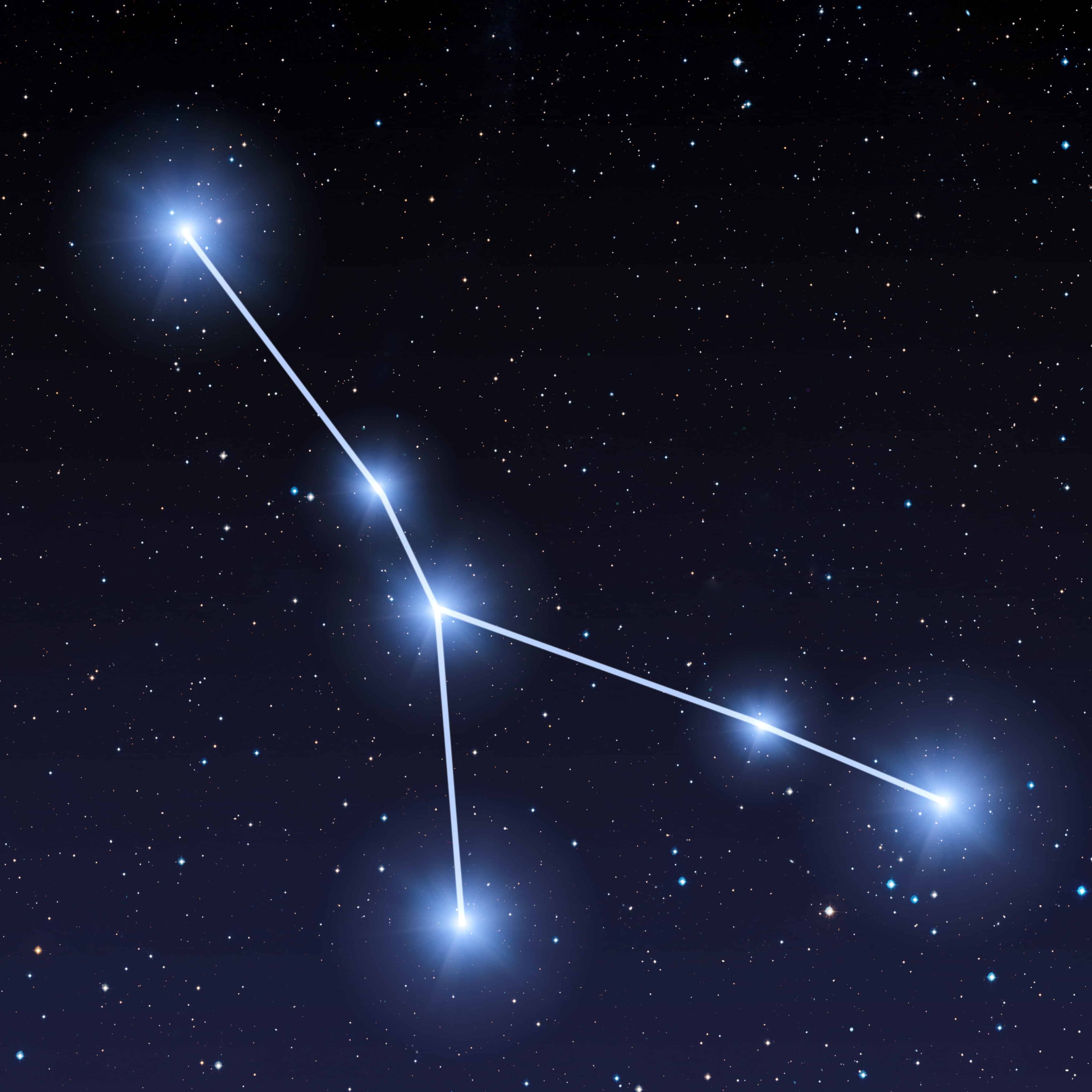Located on the ecliptic, Cancer (the “crab”) is one of the twelve constellations of the zodiac and is found in the northern celestial hemisphere. Cancer is a medium-sized constellation with an area of 506 square degrees and is home to many exciting deep-sky objects, many of which will be discussed in this ultimate guide to the Cancer constellation.
Contents
Origin & Facts
Cancer was first recorded by the ancient Greek astronomer Ptolemy in the 2nd century AD in his written mathematical and astronomical treatise, the Almagest. In ancient times, Cancer played an important role in marking the seasons, indicating the summer solstice. Now, due to the precession of the equinoxes, the corresponding position in the sky of the summer solstice is in Taurus. However, the northernmost parallel, where the sun is directly overhead at 23.5 degrees is still referred to as the Tropic of Cancer for this very reason.
Because of the fact that many of its stars are not visible to the naked eye (unlike many other constellations of the zodiac), Cancer was often referred to as the “dark sign,” described as “black and without eyes” in Dante Alighieri’s Paradiso in the Divine Comedy.
The occurrence of a close conjunction of Jupiter with Saturn in Cancer in 1563 was also observed by astronomer Tycho Brahe, which led him to discover the inaccuracy of existing ephemerides and write up his own astronomical measurements.
The Mythological Legend of Cancer
Cancer originates from Greek mythology, associated with the crab sent by Hera to defeat Heracles. Heracles, also known as Hercules, was the son of Zeus and the mortal woman Alcmene, making him a demigod. Hera, being married to Zeus, hated Heracles because he was the son of one of her husband’s affairs. In her dislike for Heracles, Hera tried many different ways of killing him or making his life miserable, but she was always defeated by his incredible physical prowess.
In an attempt to steal his happiness, she cast a spell on him, causing him to go mad and commit atrocities. When the spell dissipated and he saw what he had done, he fell into incredible grief, eventually visiting the Oracle at Delphi and asking how he could be forgiven. She told Heracles that he must serve his cousin Eurystheus for ten years and complete impossible tasks for him to pay for his sins.

The majority of the impossible tasks were slaying various monsters and beasts: The Minotaur, Hydra, Athena’s deer, and many others. During the battle between Heracles and Hydra, the goddess Hera sent a giant crab to aid the serpent dragon. Heracles, being as strong as he was, killed the crab simply by smashing its shell with his foot. As a reward for the crab’s service, Hera placed it into the night sky as a constellation, becoming what is known as Cancer the crab.
Location
The constellation of Cancer is located on the ecliptic, meaning that it is on the same invisible path as the sun, passing through it during the months of late June and July. For nighttime observations, Cancer is best visible in the early spring in March (autumn in the Southern Hemisphere), when it hits the meridian at about 9 pm local time.
The constellation is seated between neighboring constellations Canis Minor, Gemini, Hydra, Sextans, Leo, and Lynx. It also contains ten named stars, all of which are dim, making it a bit of a challenge to spot in the sky and navigate. The brightest star, Tarf, is only magnitude 3.5 but can be found at the southwestern corner of the constellation.
The Cancer constellation as illustrated by the IAU and Sky & Telescope
At the meridian, Cancer orients itself sideways, its legs and pinchers forking out on the far north and far south sides. It is to be noted that this constellation is only visible to those from latitudes +90° to -60° because of its positioning at 30 degrees.
Notable Stars in Cancer
Acubens (α Cancri)
Acubens, despite being the fourth brightest star in Cancer at magnitude 4.2-4.3, is designated as α Cancri. It is also sometimes referred to as Al Zubanah or Sertan, translated from Arabic as “claws” and “the crab” respectively.
Acubens is a multi-star system located roughly 170 light-years from Earth. The two brightest components make a 0.1-arcsecond binary, which is a tough binary to visually split without the help of a decently large refractor and a night of great seeing conditions.
Tarf (β Cancri)
Tarf is the brightest star in Cancer, with an apparent magnitude of 3.5 and a distance of 290 light-years. Similar to Acubens, this one is a visible double star but is one that is much easier to split. It consists of an orange K-type giant and a dim companion star 29 arcseconds away.
The traditional name is believed to be derived from the Arabic translation meaning “the eye” or “the glance”. Tarf has also been a subject of interest for exoplanet hunters since 2014, when measurements of radial velocity data indicated a possible planet orbiting the star. In such a case, the planet is estimated to have a minimum mass of 8 times the size of Jupiter along with an orbital period of 605 days.
Asellus Australis (δ Cancri)
Delta Cancri is an orange giant star with an apparent magnitude of 3.9, making it the second brightest star in Cancer. At 180 light-years away, it is the home of the Beehive Cluster, a well-known open cluster.
The other nickname for the star is Arkushanangarushashutu, which is the longest formal star name in existence, and probably why it is more commonly called Asellus Australis. This long nickname originates from Babylonian, meaning “the southeast star in the crab”, consistent with its location.
Asellus Borealis (γ Cancri)
Asellus Borealis is a white subgiant located roughly 160 light-years from the Solar System. In Latin, Asellus Borealis means “northern donkey colt,” which is in contrast with Asellus Astralis, which means “southern donkey colt.” Since Gamma Cancri is on the ecliptic, it can be occulted by the Sun or Moon, similar to Alpha and Delta Cancri.
Tegmine (ζ Cancri)
Tegmine is a multi-star system located a mere 83.4 light-years from Earth that contains at least four stars. Its name translates to “the shell of the crab.” Zeta Cancri is composed of two sets of binary stars, a pair separated by 5 arcseconds, as well as a binary pair separated by only 0.3 arcseconds.
The former double star system can be pretty easily split with small telescopes on a night of good seeing, but the latter cannot without a larger telescope.
Copernicus (55 Cancri, ρ1 Cancri)
55 Cancri, also nicknamed Copernicus after the great mathematician and astronomer Nicolaus Copernicus, is a double star composed of a yellow main-sequence dwarf and a red dwarf located 41 light-years away.
This star system is especially interesting because as of 2010, astronomers have confirmed five exoplanets orbiting its primary star, making it one of the four known planetary systems with more than five planets. The planet nearest to the star is believed to be a solid planet within the star’s habitable zone with a mass comparable to that of Neptune and temperatures similar to Earth, making it a “super earth.” The other four planets are gas giants with masses comparable to Jupiter. In the spirit of things, Copernicus’s planets are named in order of distance from the star after famed astronomers. These nicknames are Janssen, Galileo, Brahe, Harriot, and Lipperhey. It is thought that there could be more planets than just the five, but this hypothesis has yet to be backed by data. The existence of moons around the exoplanets is possible, which, if sizeable enough, could give ingredients for simple microbial life.

λ Cancri
Lambda Cancri is a blue-white spectroscopic binary star with a visual magnitude of 6, meaning it is faintly visible to the naked eye, but the only evidence of it being a binary star is from spectroscopic measurements of doppler shift.
Based on recent precise parallax measurements, it is estimated to be 550 light-years distant.
Nahn (ξ Cancri)
Xi Cancri, similar to Lambda Cancri, is another spectroscopic binary star that is also known as Nahn. At 381 light-years away, Xi Cancri consists of a yellow giant with a magnitude of 5.16, along with a companion star located 0.1 arcseconds away.
Meleph (ε Cancri)
Meleph, also designated as Epsilon Cancri, is a double main-sequence star. Its visual magnitude sits at 6.3, which is only visible to those in dark skies with full dark adaptation. Despite its relative faintness, it is one of the brighter stars in the Beehive Cluster (M44)
It can be found (along with the rest of the beehive cluster) between and slightly west of the stars Asellus Borealis and Asellus Australis.
χ Cancri
Chi Cancri is a candidate astrometric binary star system in Cancer, meaning that it appears to orbit around a point in space with no physically visible companion. The visible star has a yellow-white hue and is dimly visible to the naked eye with an apparent visual magnitude of 5.14. The system is located 59 light-years from Earth and is quickly drifting away from us at a rate of 33 km/s. It is thought that the star system swung within 41 light-years of us some 274,000 years ago.
The visible component is an F-type main-sequence star with a mass similar to our sun and is similar in age as well. However, it is theorized that a circumstellar disk of dust orbits the star as given by measurements of the system’s infrared flux.
ι Cancri
Iota Cancri is a double star that is 300 light-years distant. The two stars of Iota Cancri are separated by an entire 30 arcseconds, changing very slowly. Even though we haven’t accurately measured the orbital motion of the pair, it is thought that the two are gravitationally bound to each other.
The brighter star, Iota Cancri A, is a G-type yellow giant with a magnitude of 4.01. Emission lines measured from this star indicate that there may also be a hidden white dwarf star that we cannot see, creating a slow mass transfer between the two, but no such thing has been physically observed. The fainter of the two stars, Iota Cancri B, is a white A-type main sequence dwarf with an apparent magnitude of 6.57.
Deep Sky Guide
Beehive Cluster (Messier 44)
The Beehive Cluster, cataloged by Charles Messier in 1769, is a naked-eye open cluster located about 577 light-years from Earth. The great ancient Greek astronomer Ptolemy was one of the first individuals to record an observation of it, referring to the cluster as “the nebulous mass in the breast of Cancer.” However, Galileo Galilei was the first person to view it through a telescope, and Messier was the first person to catalog it.
The open cluster contains more than 1,000 stars, most of them red dwarfs and sun-like main sequence stars. Though most of the stars are faint to the naked eye, it is still visible as a faint fuzzy, but can easily be resolved into its individual stars with even a small telescope or set of binoculars.
Since it is a naked-eye object, it is easy to find under dark skies. However, those who are not under dark skies may need the assistance of star hopping to find it. Luckily, this object is really easy to star hop to as well since it is located directly in the middle (and slightly to the west of) Asellus Borealis and Asellus Australis.
Messier 67
Messier 67 is an open cluster and one of the oldest ones at that. It is estimated to have a collective age of 3 to 5 billion years, making it a highly observed and studied object for those interested in researching stellar evolution. M67 contains hundreds of sun-like stars and a decent amount of red giants as well, all roughly the same age and distance from us.
This open cluster can be found at the southeastern end of Cancer, a little more than 3 degrees west of the star Acubens. It takes on a shape similar to the Beehive Cluster, but is far dimmer and more compact. In such a case, you would find more satisfaction in using a telescope to view it properly instead of just a pair of binoculars.
NGC 2775
Located at a huge 67 million light-years away from Earth, NGC 2775 is a spiral galaxy discovered and cataloged by William Herschel in 1783. Its morphological classification indicates that it is an unbarred spiral galaxy with a prominent ring structure and tight spiral arms. NGC 2775’s spiral arms are also home to a few H-II regions, meaning there has been recent star formation. This one is a bit tough to star hop to, but it can be found as the eastern corner of an isosceles triangle (almost right triangle but not quite) made from Acubens and one of the head stars of Hydra, Ashlesha.

NGC 2535/2536
NGC 2535 and NGC 2536 are a pair of interacting spiral galaxies, the former an unbarred spiral with an apparent magnitude of 16.9, and the latter a barred spiral with a magnitude of 14.6. Because of its tiny angular size, it is unfortunately invisible to visual observers. Even if the pair were larger, the magnitude would require that you own a large telescope to even barely see it.
NGC 2500
NGC 2500 is a barred spiral galaxy located 33 million light-years from Earth, sitting at an apparent magnitude of 12.2. This means that it is definitely not visible to the naked eye, but can be seen in small telescopes. It was first discovered in the late 18th century by the astronomer William Herschel. NGC 2500 belongs to the NGC 2841 galaxy group, along with galaxies NGC 2537, NGC 2541, and NGC 2552.
This galaxy is tiny in telescopes, having an overall diameter of less than 3 arcminutes, but it is viewable.
NGC 2608
NGC 2608 is a barred spiral galaxy that is over 60,000 light-years in diameter with an apparent magnitude of 13. At 93 million light-years away, its morphological classification indicates that it has moderately wound spiral arms around its prominent central bar.
This galaxy has been a subject of interest because of two supernovae that occurred inside of it in recent history, the first of which was a magnitude of 11.7 in 1920, and the second a magnitude of 13.7 in 2001. Similar to NGC 2500, this galaxy is small in angular diameter, but is also slightly dimmer, making it a challenging visual target. Its core is a good bit brighter than its surroundings and the galaxy is somewhat elongated, but it is still hard to find if you don’t know what you’re looking for. The location is NGC 2608 is near the northern portion of Cancer, about halfway between Iota Cancri and Chi Chancri.

